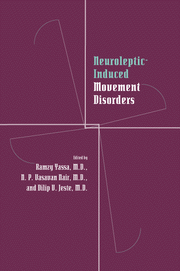Book contents
- Frontmatter
- Contents
- Contributors
- Preface
- Part I Historical perspective
- Part II Clinical aspects of tardive dyskinesia
- Part III Mechanisms underlying tardive dyskinesia
- Part IV Measurement of tardive dyskinesia
- Part V Tardive dyskinesia in different populations
- Part VI Other neuroleptic-induced movement disorders
- Part VII Treatment of tardive dyskinesia
- 28 Development of novel antipsychotic drugs with reduced extrapyramidal side effects
- 29 GABAergic treatments for tardive dyskinesia
- 30 Using biofeedback to train suppression of the oral-lingual movements of tardive dyskinesia
- Index
28 - Development of novel antipsychotic drugs with reduced extrapyramidal side effects
from Part VII - Treatment of tardive dyskinesia
Published online by Cambridge University Press: 09 October 2009
- Frontmatter
- Contents
- Contributors
- Preface
- Part I Historical perspective
- Part II Clinical aspects of tardive dyskinesia
- Part III Mechanisms underlying tardive dyskinesia
- Part IV Measurement of tardive dyskinesia
- Part V Tardive dyskinesia in different populations
- Part VI Other neuroleptic-induced movement disorders
- Part VII Treatment of tardive dyskinesia
- 28 Development of novel antipsychotic drugs with reduced extrapyramidal side effects
- 29 GABAergic treatments for tardive dyskinesia
- 30 Using biofeedback to train suppression of the oral-lingual movements of tardive dyskinesia
- Index
Summary
The introduction of antipsychotic drugs such as chlorpromazine (CPZ) in the 1950s was a major advance in the treatment of schizophrenia and other psychotic disorders. Although CPZ and other typical antipsychotic drugs remain important, the limitations imposed by their adverse reactions and partial efficacy in a significant proportion of schizophrenic patients are widely recognized. The most prevalent and most troublesome adverse drug reactions associated with the typical antipsychotics are their acute and chronic extrapyramidal motor side effects (EPSEs). In contrast, the “atypical” antipsychotic drugs that have recently been marketed (e.g., clozapine, risperidone, and remoxipride) or that are in various stages of development are expected to entail significantly lower incidences of EPSEs and possibly offer greater therapeutic efficacy. This chapter focuses on how these new developments in antipsychotics will affect the incidence and severity of acute and chronic EPSEs.
Acute and Chronic EPSEs
The common acute EPSEs associated with typical antipsychotic treatment include drug-induced parkinsonism (characterized by tremor, rigidity, and bradykinesia), acute dystonic reactions, and akathisia (subjective and objective motor restlessness). Those side effects can lead to a wide range of deleterious clinical consequences: disruption of the doctor–patient therapeutic alliance; noncompliance with the prescribed treatment/medication (Van Putten, 1974; Kane, 1990); physical and emotional distress, resulting in a reduction in the overall quality of life and in poorer social and vocational functioning; behavioral toxicity (Van Putten & Marder, 1987), including “secondary” negative symptoms (Rifkin, Quitkin, & Klein, 1975; Van Putten & May, 1978) and cognitive impairment; cosmetic disfigurement, which can contribute to social isolation and stigmatization.
- Type
- Chapter
- Information
- Neuroleptic-induced Movement DisordersA Comprehensive Survey, pp. 427 - 453Publisher: Cambridge University PressPrint publication year: 1996



